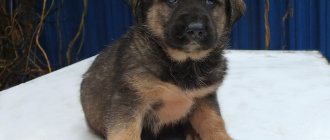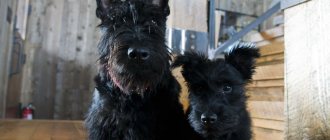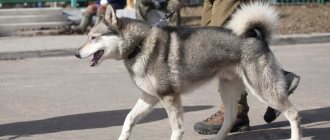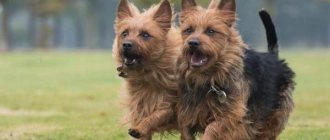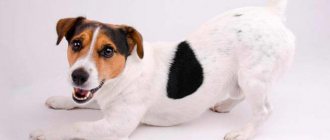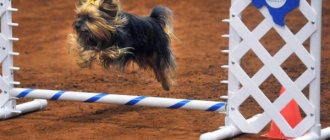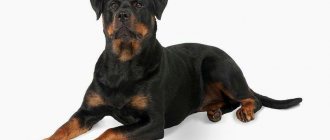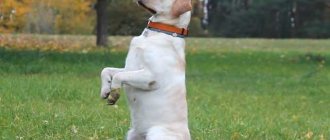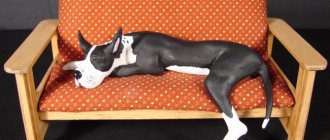The Scottish Terrier has acquired the popular nickname “gentleman in a skirt.” A rectangular beard, a carrot tail and always dignified behavior. The Scottish Terrier is a hardy, fearless, and active working dog. Their keen intelligence and people-oriented nature have allowed the breed to remain popular despite the changing needs of society. Modern Scotties are companions, protectors and athletes and of course, hunters.
Story
Scottish Terriers are considered to have originated from Northern Scotland and the adjacent Hebrides. For centuries, small dogs were bred as rat catchers and hunters of small burrowing game. People did not give importance to appearance and standard characteristics.
The exact origin is not established, since most small terriers have the same roots. For several centuries, Scottish clans bred mongrel dogs at that time, but, due to hostility between people, the animals were not mixed with each other for centuries. According to some historical sources, dogs became a separate breed of Scotch dog in the 16th century. And only at the beginning of the 19th century did breeders pay close attention to them.
The standard was written in 1879, and in 1880 the first clubs appeared, so far only in Scotland and Great Britain. It took several decades for dogs to become widely accepted. In 1930-1940 “Scots” gained worldwide fame when many celebrities of that time became owners of representatives of the breed (among them Einstein, Mayakovsky, Utesov, Chaplin, Roosevelt, etc.).
According to the first standard, dogs should have only gray and gray colors. But in the 1930s, the requirements changed, and today the most popular are black. Breeders have been fixing this gene in the breed for a long time.
History of the breed
The breed standard was recognized at the end of the 19th century. However, its predecessors lived in the vastness of Scotland several hundred years earlier. Terriers are recognized as one of the oldest dog breeds. For a very long time they were used by peasants as rat catchers, fox, otter and badger hunters, and were excellent guards. Over time, the purpose of dogs has changed. Scotland has never been famous for its good natural conditions. This harsh place, without resources and conditions for development, did not allow the peasants to keep dogs that did not do the work required of them well. Therefore, weak individuals were disposed of.
Strict checks were often carried out on pets. So, the dog could be locked in the same barrel with the badger. In such a situation, only one is destined to survive. The weak dogs themselves could not survive in the harsh environment of Scotland. Over centuries of testing by natural conditions, terriers have turned into a brave, hardy and unpretentious dog.
Description of the Scotch Terrier
Although the dog has not lost its hunting instincts and copes well with guard duties, today it is considered decorative and is used as a companion.
Scottish Terriers, by standard, reach 25-28 cm at the withers and weigh 8.5-10.5 kg.
Head
- The stop is weakly expressed, most noticeable at eye level. The skull is large, elongated, moderately wide, flattened. Cheekbones are weakly expressed.
- The muzzle is deep, long, and the jaws are powerful. The length of the upper part of the head and muzzle is the same.
- The nose is large, black, and protrudes noticeably forward, making the upper jaw look longer than the lower jaw.
- The teeth are large and have a scissor bite.
- The eyes are set obliquely and deeply. The size is small, the cut is almond-shaped. The color is dark, brown.
- The ears are small and pointed, triangular in shape, erect. The shell cartilage is thin. Set high on the crown.
Body type
The neck is moderately long and set high.
The withers are pronounced, the top line is straight and level, the back is rather short and muscular. The loin is slightly convex, the croup is short and massive.
The chest is deep and long. The ribs are round. When viewed from the side, the breastbone protrudes forward.
Tail
The tail is vertical and short. Thickened at the base. Carried either straight and high, or slightly curved towards the back.
Limbs
Front: more massive than rear, smooth, short. The pasterns are vertical and strong.
Hindquarters: also short, muscular. The hips are massive and wide. The angles of the joints (hock and stifle) are clearly expressed. The metatarsus are vertical.
The paws are rounded, the claws are large.
Color
The standard allows only three suits:
- The most common is black.
- Wheat (or sand) of any tones.
- Motley brindle (when black and blond hair of different shades are mixed - red, gray, brown).
The white dog is considered to be a type of Scotch Terrier. But this is just a deviation from the norm.
Wool
The guard cover is thick, rough and long, with a break. The undercoat is short and soft. The guard hairs grow to 10 cm or more, covering the paws and lower part of the body (similar to a skirt or pants). A hard mustache, beard and eyebrows grow on the face (the calling card of the breed). The dog is not prone to heavy shedding.
Character
Scottish Terriers are not particularly trusting of strangers, but they are devoted to their family. Often a pet chooses one person as its owner.
Dogs do not get along with children, do not like to be squeezed and often violate the boundaries of their personal space. They do not tolerate the company of other dogs well, and they coexist peacefully with cats only after a long period of adaptation. Small animals should be kept in cages, as the dog's hunting instinct can take over.
This is interesting: 5 mistakes they make when trying to make friends between a cat and a dog
The Scots have a strong sense of self-esteem, they are reserved and courageous. The baby never attacks first, but knows how to stand up for himself and family members. Independence is manifested in everything: the dog rarely imposes its presence on its owners, quietly spends its days alone, and can keep itself busy on a walk.
Expert opinion
Anna Abramenko
An avid dog lover. Experience in veterinary medicine since 2009.
Ask a Question
Pride and dignity are acutely manifested in the process of education. A humiliated animal will refuse to cooperate with the teacher and will not obey. But skills that are not taught in time are poorly adjusted with age.
Breed characteristics and character
The first terriers were mentioned in the Middle Ages. They have been spotted in the British Isles. At that time there were a lot of colors and sizes of dogs. Small individuals were used for hunting in burrows, exterminating rodents, and poisoning small game.
Then the dog handlers divided the terriers into several “branches”, including Kern, White, West and others. The first Scotch Terriers settled in the mountains of what is now Scotland, and the name of the breed itself has a direct reference to this country.
Black and white scotch terriers
At the same time, Britain is considered the official homeland of dogs. The first standard was presented at the end of the century before last, and the breed club was founded in 1882, a year after the adopted standard.
The Scotch Terrier grumpy personality. However, absolutely all terriers are susceptible to this trait. He often has mood swings, and he won’t be able to play with them for days on end. They may not obey the owner, but in splendid isolation it is quite difficult to see them.
Overall a friendly and loyal pet, but independent and courageous. Despite his courage, he shows aggression in extremely rare cases. The four-legged pet is smart and has a genuine interest in everything that happens. Can observe and evaluate for a long time.
Due to hunting genes, he is prone to digging holes and chasing cats. The Scottish Terrier considers every cat to be its potential victim. Not every representative of the breed gets along with pets. Everything here will depend on the owner’s ability to guide the dog on the right path.
By the way, it can be difficult to train due to its arrogance. At the same time, he is quick-witted, so learning will not be difficult for him. Listening to a command that, in his opinion, is not very smart, the dog may refuse to carry it out.
So you need to interest him in something. The whip method won't work with him either. The dog does not accept physical violence. Doesn't even take shouts. The Scottish Terrier will get along with a person who has a calm disposition and does not leave home for long.
Breeding
Scots reach sexual maturity early, but it is not advisable to allow them to mate until they are 2 years old (for females it is possible at 1.5). Otherwise, the animal’s body will not have time to form, and diseases and physiological defects will appear.
Mating takes place in the male dog's territory. The subsequent pregnancy lasts 60-62 days (but an interval from 58 to 72 is acceptable). If labor does not occur, a caesarean section will be required.
Expert opinion
Anna Abramenko
An avid dog lover. Experience in veterinary medicine since 2009.
Ask a Question
The owner must carefully monitor the condition of the expectant mother throughout the entire period, especially for the first time. By the time of birth, it is necessary to carefully prepare the place, accustom the dog to it and always be on the alert. And in case of complications, immediately call a veterinarian.
Health
The Scottish Terrier can live 12-15 years. If you take good care of him, his life expectancy can reach 18 years. By choosing a breeder responsibly, you can count on the fact that Scottish Terrier puppies will have strong immunity. And timely vaccination will reduce the risk of developing viral infections to zero.
Among the pathologies of terriers the following can be distinguished:
- Hypothyroidism. Characterized by dysfunction of the thyroid gland.
- Females experience complications during childbirth. This does not have the best effect on the condition of the puppies.
- In the early stages of development (20-25 days), puppies may experience congenital deafness.
- The Scottish Terrier may develop seizures. This is not epilepsy. This pathology is transmitted from ancestors to descendants. Since the root cause of this pathology has not yet been identified, the pet is treated for the symptoms of the disease.
- Pseudogemophilia is a hereditary pathology that was included in the list of probable diseases of terriers quite recently. The disease manifests itself as follows: the mucous membranes begin to bleed. The danger of the pathology is that the pet may experience internal bleeding, but there will be no external signs. The owner will not be able to recognize the danger in a timely manner. As a result, everything can end in disaster.
- In their later years, terriers may develop cataracts.
Among the most dangerous hereditary diseases are cancer.
Education and training
The Scots are independent and always confident that they are right, so the learning process should be presented to them in the form of a game or cooperation. This will require a lot of patience on the part of the owner.
It is necessary to begin training a few days after the puppy arrives in the new home, when he looks around and gets used to the environment. You should not immediately start learning commands - new skills should be introduced gradually. At first, you will have to prohibit your pet from chewing things and furniture and hiding shoes.
In order for your pet to exercise with pleasure, you need to encourage and praise him more often, but at the same time show firmness and perseverance. If you miss the time to start training (age 2-3 months), then later it will be more difficult to achieve obedience. First skills: walking on a leash, name and toilet training.
The pet can easily master basic commands (“sit”, “place”, “lie down” or “come”), since dogs have a fairly high intelligence. From the first days, systematicity is important. The baby will also appreciate the appropriateness of the commands. The teacher should not offer a haphazard set of tasks, but be sure to tie lessons to situations.
It is better to entrust a serious training course to professionals.
Expert opinion
Anna Abramenko
An avid dog lover. Experience in veterinary medicine since 2009.
Ask a Question
Scots often succumb to hunting instincts and can rush in pursuit of a cat or bird. Therefore, it is better to use a leash for walks.
See also: training puppies of all breeds
Description of the breed
The Scottish Terrier boasts a compact body. His short legs are quite strong. It has a small head that is proportional to the body.
The breed standard is characterized by the following characteristics:
- Dense build, weighed down by a bone frame.
- The muzzle is elongated, tapering towards the nose. The color of the lobe does not affect the color of the individual; it is exclusively black.
- Even teeth are strong and have a scissor bite. The powerful jaw is square in shape.
- The eyes are small, deep-set and widely spaced, almond-shaped.
- The ears are small, erect, high, and pointed at the ends. Thanks to this arrangement, the dog has a wary, serious appearance.
- The neck is thickened, the muscles on it are well developed.
- The tail thickens towards the base; when moving, it is raised, but does not lie on the back.
- The legs are strong, straight, and have good muscle mass.
- The coat of dogs of this breed is long, hard, and has a soft and short undercoat. White color is considered a breed defect.
A detailed description of the breed allows you to determine whether it is a pure Scottish Terrier or a mixed breed.
Character
The character of the breed is amazing, because the pet is distinguished by equanimity and nobility. Endowed with excellent hunting characteristics. It amazes with the insight of the mind and the sensitivity of the soul. Dogs harmoniously combine stubbornness with mischief and playfulness. In everyday situations, the pet behaves calmly, without fuss. But when you go out for a walk and see a cat, your mood quickly changes. Not a trace remains of intelligence and calmness.
To avoid unpleasant situations associated with chasing cats or rodents, your pet must be raised to eradicate these qualities.
Dog training must be carried out with rigor and persistence. It is forbidden to beat an animal; this will negatively affect the education of a full-fledged personality. For people from Scotland, leisurely, sedate activities are suitable. Scottish terriers can become attached to not just one, but several family members at once. They perfectly adapt to the mood of the owner.
Pets show restraint towards unfamiliar people. When seeing an animal for the first time, there is no need to try to stroke or touch it, it definitely will not like it. Children are treated friendly. Scottish terriers are distinguished by their desire to bark at any opportunity, and sometimes just because.
Care and maintenance
A dog can live in a private house or in an apartment. To make your pet look beautiful and healthy, you must follow several rules:
- If you don't take care of the coat, it will look unkempt and tangles will appear. The dog is combed twice a week, after moistening the fur (the fluff is not prone to constant shedding, but can cause dermatitis).
- Once a month and a half, long hair is trimmed. A non-show dog can be served at home. A full haircut is done every 2-3 months.
- Washing is carried out with dog care products at least once a month.
- It is necessary to plan walks at least 2 times a day, during which the animal will have time to relieve itself and get a good workout. You should not let him off the leash in the middle of the street or in a crowded place, as Scotch dogs love to bark at passers-by and cars and always chase cats.
- To maintain good health and an attractive coat, it is important to periodically give your dog vitamin supplements.
- Nail cutting and ear treatment are required once every 1-1.5 months.
- Daily procedures are periodically necessary: brushing your teeth (with bones from the store or toothpaste), wiping your eyes with a damp cloth.
- The anal glands are checked and cleaned once a quarter.
You need to accustom your puppy to hygiene procedures from an early age.
Feeding
A balanced diet for a dog is the key to health and longevity. This hackneyed phrase is the ultimate truth! Many owners believe that nothing will happen from cookies, caramel will not harm, fresh bread is tasty for dogs, etc. Our pets do not speak, they cannot explain when their stomach hurts or when food is uncomfortable. The owner notices the damage after the fact, and if there are no visible consequences, then there are no problems.
Scotties are prone to atopic dermatitis, which is the body's reaction to something unnatural. Atypical food, a cheap plastic bowl, a low-quality bed, any item in the house or on the street can become a source of problems. At the slightest manifestation of dermatitis (first of all), reconsider feeding! Even high-quality, but out-of-season products may contain substances (chemicals, gas residues, paraffin, tannins) that the dog’s body does not accept.
The Scottish Terrier adapts equally well to balanced natural food and high quality feed. By conducting regular vitamin courses, the owner can feed the dog premium food. Super-premium and holistic foods already contain all the vitamins and microelements, so additional feeding will be unnecessary.
Advice: vitamin supplements are not cheap. Try to choose small complexes (3-5 components) and alternate them. The more expensive and massive the additive, the worse it will be absorbed. Don’t forget about the available analogues: bone meal, fish oil, nutritional yeast, dried seaweed, etc.
Nutrition
Dogs are prone to overeating, which means owners need to carefully control the amount of food they eat to avoid obesity. To do this, you need to adjust the diet and not feed your pet from the table.
Basic prohibitions:
- raw foods are easier to digest, so heat treatment is undesirable;
- excess fat negatively affects the liver;
- Flour products, sugar and artificial additives (dyes, flavor enhancers) are extremely harmful to the dog’s body.
If the owner has chosen to eat store-bought food, then they should choose only high-quality and proven, best brands. Natural food should contain products:
- the basis of the diet is 70-80% lean meat with cartilage (cut into pieces and served raw);
- cereals (rice, oatmeal, buckwheat);
- vegetables and fruits;
- boiled eggs;
- dairy products;
- sea fish.
Expert opinion
Anna Abramenko
An avid dog lover. Experience in veterinary medicine since 2009.
Ask a Question
During the period of teeth growth, it is necessary to give the dog large bones without sharp edges or buy their substitutes in pet stores.
Health and illness
Scottish Terriers are strong and hardy animals. But there are a number of ailments that are most often found in this breed:
- Eczema (usually in the back area), hair falls out in wet areas.
- Leukemia (blood disease) that affects dogs under 5 years of age. The first symptoms are refusal to eat, weakness and diarrhea. The pet loses weight, anemia appears, the temperature may rise, lymph nodes and some organs enlarge.
- Diseases of the blood (especially hemophilia) and liver.
- Retinal atrophy, progressing to blindness.
- Difficult birth.
- Hereditary epilepsy.
- Tumor diseases.
Expert opinion
Anna Abramenko
An avid dog lover. Experience in veterinary medicine since 2009.
Ask a Question
A responsible owner should vaccinate his pet in a timely manner, take him for checkups to the veterinarian, and immediately contact the clinic if alarming symptoms appear.
Possible diseases
The Scottish Terrier breed , as a rule, has good immunity. It is purchased with mother's milk. But throughout life it is influenced by factors such as a balanced diet, timely vaccination, and proper care. Vitamin supplements are optimal for prevention. They should be used if the dog eats natural food. Walking is also beneficial.
Mom scotch terrier with puppy
The future owner should keep in mind that the dog is susceptible to skin diseases. These include atopic dermatitis and allergies. Mast cell cancer and melanoma, a malignant tumor of the skin, are possible. Lymphosarcoma often occurs.
Among the endocrine diseases, hypothyroidism is a popular disease – insufficient function of the thyroid gland. The disease manifests itself in a change in the dog’s appearance - the skin becomes dull, constant shedding begins, hair loss begins, the dog becomes apathetic and lethargic, and its character changes.
Among the ophthalmic ailments, the Scotch Terrier is most often affected by cataracts. In addition, the dog may suffer from bladder cancer and von Willebrand disease. Viral diseases – plague, hepatitis, rabies – cannot be excluded. These are dangerous illnesses that can end in disaster. As a preventive measure, vaccinations and hygiene rules are required.
Any of the listed diseases requires consultation with a specialist. It would also be a good idea to register with a specific veterinarian and take your pet for preventive examinations from time to time.
Advantages and disadvantages
The positive properties of the breed include:
- small size and decorative;
- the ability to leave your pet alone for a day;
- devotion, unobtrusiveness, poise;
- good health.
Main disadvantages:
- complex nature;
- regular grooming;
- love of fighting;
- strained relationships with children and pets.
Despite its shortcomings, the breed is very popular among dog breeders.
List of nicknames
Choosing a name for a pet is not an easy task. Even high-born dogs, which are called according to the rules by breeders, have a second nickname, which they will respond to.
There is no need to rush to make a choice. Perhaps, after two days of communication with the baby, a solution will be found on its own, since during this time the pet will have time to show its character.
By nature, Scots are energetic, determined and confident, and will benefit from names that reflect these characteristics. It is desirable that this be an easily pronounced version, consisting of 1-2 syllables.
What to name a boy:
- Arthur, Archie, Argo, Cupid, Ice;
- Barney, Baron, Boy, Black, Bob, Bim, Butch;
- Volt, Jack, Vinny, Venya;
- Thunder, Harry, Gray, Earl, Homer, Gimli;
- Dick, Jack, Jim, Dandy, Donald;
- Euro, Jacques, Zeus, Zorro, Kuzya, Kex, Krosh, King, Cooper;
- Lord, Louis, Leo, Loki, Luke, Max, Martin, Mickey;
- Mars, Nick, Nord, Nike, Neo, Nemo, Oscar, Persian, Pirate;
- Perry, Pumbaa, Prince, Rex, Roy, Ralph, Rambo;
- Scooby, Spike, Styopa, Tim, Tyson, Timka, Urry, Fox, Frodo, Bassoon.
Nicknames for girls:
- Alice, Alma, Asya, Bonnie, Busya, Bella, Belka, Bulya, Barbie;
- Vika, Wanda, Gerda, Greta, Goldie, Hera;
- Dina, Jeri, Jesse, Julie, Demi;
- Eva, Elka, Zhadi, Jasmine, Zhudi, Zhulya;
- Zara, Zita, Irma, Izi, Ivi, Inga;
- Knopa, Cuba, Coco, Kara, Capa, Christy;
- Lapka, Lucy, Lada, Lucky, Lisa, Linda;
- Martha, Mary, Maggie, Manya, Maya;
- Nika, Naida, Nyura, Nancy, Nicole, Ophelia;
- Puma, Polya, Palma, Rada, Rose, Ruby, Rita, Rimma;
- Sonya, Sophie, Cindy, Uma, Fiona, Phoebe, Fairy, Frosya, Frida;
- Chelsea, Blueberry, Ella, Ani, Ashley; Yumba, Yula, Yana, Yara.
Scottish Terriers are small but noble aristocrats, so names of foreign origin would be appropriate.
Rules for choosing puppies
When choosing a puppy in a nursery, you need to focus on several points:
- producers – purebred “Scots” with excellent pedigree;
- puppies live in good conditions;
- the appearance of the small terrier does not contradict the requirements of the standard;
- his behavior corresponds to the norms: there is no unnecessary timidity or aggression;
- The dog looks healthy, well-fed, cheerful and active.
Before purchasing, it is important to familiarize yourself with the breed standard and descriptions. But this will not always help to see a future champion in a 1.5-2 month old toddler.
Cost and buying tips
If the owner wants to participate in exhibitions with the dog, and simply get a healthy and purebred dog, then it is necessary to buy a Scotch Terrier puppy from nurseries that specialize in breeding this breed or from professional breeders. Together with the dog, the owner will receive all the documents due and any information on care, education or feeding.
Prices for babies depend on the class, compliance with standards, title of manufacturers and region. On average, the amount ranges from 10 to 80 thousand rubles.
Breed price
Before you buy a Scotch Terrier, you need to decide on such components as the purpose of the purchase, the gender of the dog, the place where the transaction will be completed, and more. If the purpose of buying a dog is breeding and participation in exhibition events, then the choice should be approached with maximum responsibility.
To begin with, study the breed standard and everything that can disqualify a dog. In addition, you need to prepare a certain amount of money. The price of a show-class Scotch Terrier , namely these representatives are allowed both for mating and for exhibitions, will cost a pretty penny, amounting to more than 70 thousand rubles.
However, if there is no desire to win medals, then you can limit yourself to simply breeding puppies. In this case, you will have to invest about 50 thousand, but it will pay off handsomely through mating and sale of offspring. The simplest option is a dog for the soul, a pet class. It will cost an order of magnitude cheaper than the listed classes. At the same time, he will also have all the documents, pedigree and vaccinations.
In all cases, the optimal place of purchase is dog kennels. The future owner can be sure: they won’t slip him a linden tree here. But at bird markets or through an advertisement on the Internet, this could very well happen. However, the ad is different from the ad. And on Avito you can meet conscientious official breeders. But you have to look for them.
Interesting Facts
- Such a disadvantage as the Scots’ dislike for children is the consequences of socialization errors and the inattentive attitude of adults. It is important to prepare your child for buying a dog and teach him how to properly handle animals. The puppy should also know the hierarchy from the first day in the family and not try to subjugate the children.
- The unusual appearance has become the reason that the image of this particular breed is found everywhere and more often than others.
- The dogs are called Scottish terriers, but Great Britain is considered their homeland, since they began to be purposefully selected there.
- The dog performed in the circus with the famous clown Pencil. Over the entire period, 17 different “Scots” played the role.
- There were many celebrities among the owners of Scotch dogs; there are several monuments on which dogs are immortalized along with their owners.
The breed is the pride of Scotland. Animals are often dressed up in national costumes for celebrations.
Historical reference
The Scottish Terrier is often described as the oldest breed line in Scotland, but there is no clear version of its origin. The history of the breed began in the late seventies of the 19th century.
From the diaries of a dog lover, traveler and captain V. McKee, it became known that each region of Scotland had its “own” terriers. Small bearded dogs protected food supplies and houses from rodents . The dogs varied significantly in color and appearance, but were “called” Scottish terriers.
This is interesting! Scotch Terrier and Scottie are abbreviated names for the breed. Officially, the four-legged dogs are called Scottish Terriers. In some countries the name Aberdeen Terrier is relevant.
McKee became the first Scottie breeder; he crossed dogs of a certain conformation, but did not know his final goal. The man took his hobby quite seriously; the best dogs, in his opinion, were shown at exhibitions as guests. Dog experts treated the Scottish Terrier favorably, although not many of them believed that such an active dog would adapt to living in a home.
Despite all the adversities, the Scottish Terrier breed quickly gained popularity. The dogs were bred in Great Britain and the United States of America. British breeders have been particularly successful, producing dozens of famous breed lines.
In America, the popularity of the breed was expressed a little differently; four-legged animals often appeared in the media, magazines, books and films. Fans of the breed were willing to pay thousands of dollars for a puppy brought from another country.
Recognition of the breed was forced to be postponed as the world was overtaken by war. A long break in factory work led to the formation of different types of Scottie breed lines in Scotland, England and America. The first description of the breed appeared in England. American breeders bred larger dogs and only 8 years later (in 1900) they came to terms with the English standard.
The popularity of the breed can be judged by its famous owners. Franklin Roosevelt, 32nd President of the United States, loved his Scottish Terrier and often appeared in public with him. George Bush, famous throughout the world, was the owner of two Scotch terriers, Barney and Beasley. Adolf Hitler himself, or rather his life partner, adored Scottie. The well-known Vladimir Mayakovsky was the owner of a Scotsman named Puppy. Rock musician Viktor Tsoi was also a fan of the breed.
Reviews
- “Our Archie as a child was good-natured and hooligan (chewing shoes, furniture, books), and with age his character appeared. Does not tolerate familiarity towards himself, prefers to be on an equal footing with people, independent. So we not only love him, but also respect him as a person.”
- “I dreamed of a Scottish Terrier for a long time before buying a puppy. A convenient option for a small apartment, especially if you walk more often. There are no problems with the dog except the fur. I tried to cut my hair myself, but without the skill and equipment it’s impossible. And if you don’t trim your dog’s hair regularly, it becomes like a mop, gets very dirty, and collects debris and dirt. But all the same, we don’t want another dog now.”
- “The breed is amazing. This small animal has a strong personality, pride and independence. It is unobtrusive in communication, but will never refuse to play or lie on the couch with its owner. If you take good care of it, there will be almost no hair in the house. I definitely recommend it to lovers of small breeds.”
The dog has a cute appearance, but a complex temperament and some peculiarities in care, so it is not suitable for everyone. However, owners of Scotch Terriers will forever remain fans of this breed. Bad habits and character flaws are corrected by timely and correct education.
Breed standard
The dog's skull is almost flat, but wide. The stop is not too pronounced, but nevertheless distinct. The large nose has black pigmentation, and the muzzle is deep and voluminous. The teeth are set in a scissor bite. The Scotch Terrier at the world with dark brown, wide-set, almond-shaped eyes with a smart, piercing expression. The thin, triangular ears are set high on top of the skull and stand upright.
The muscular neck flows into a straight body with a short back and solid loin. The wide chest is dropped between the front legs. The tail is of medium length, thick at the base and tapering towards the end. The dog carries it either vertically or at a slight angle.
The paws are straight and bony, the endings are well developed - strong pads, toes together, compressed into a ball. The hind legs are very powerful, with large hips.
The wool fits tightly to the body, feels hard to the touch, and resembles wire. The undercoat is short and soft. Together, the two layers perform protective functions, helping their owner not to get too dirty and not freeze in severe frosts.
Black, brindle and wheaten colors are acceptable. And although in life there are even white Scotch Terriers , breed standards do not recognize albino. Accordingly, he is not allowed before exhibitions. With a height of up to 29 cm, the weight of the animals does not exceed 11 kilograms.
Scottish Terrier on a walk in the spring
Disqualifying faults include dogs that are fearful and overly aggressive. In addition, all animals with physical or mental disabilities. Important: male dogs must have two full-fledged testes, which are lowered into the scrotum.
Photo and video review
For those who still doubt whether to get a Scottish Terrier, we suggest you look at a detailed photo and video review.
